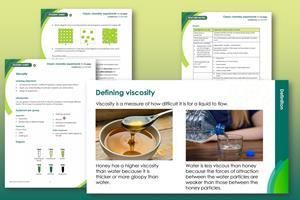Compare the viscosity of different liquids, from cooking oil to water, with this simple practical
Provide learners with a set of identical tubes each containing a different liquid and instruct them to measure the time taken for a bubble to rise through the liquid. This is used to compare the viscosity of the liquids.
-

Download this
Everything you need to run this practical lesson with classroom slides, scaffolded and unscaffolded student worksheets and teacher guidance, including full technical notes and answers to all questions.
View and download more Classic chemistry experiments
Learning objectives
- Compare the viscosity of different liquids by making careful observations.
- Apply your understanding of particles to explain your observations.
- Design an experiment.
Learners will meet objective 1 as they carry out the experiment, complete a results table and answer questions 1−3 on the student worksheet. They will meet objective 2 by correctly answering questions 4−6 on the student worksheet and objective 3 by answering questions 7 and 8 on the student worksheet.
Scaffolding
There are two versions of the student worksheet:
- The scaffolded student sheet (✪) offers additional scaffolding and support, such as fill-in-the gap style questions and a structure strip to help design an experiment;
- The unscaffolded student sheet (✪✪) has similar questions but with free text answers.
Integrated instructions are included in the presentation.
Technician notes
Read our standard health and safety guidance and carry out a risk assessment before running any live practical.
Equipment (per group)
Apparatus
- Stopwatch
- Sealed tubes of different liquids
Chemicals
Choose from:
- Water
- Cooking oil
- Washing up liquid
- Ethanol (DANGER: highly flammable liquid and vapour)
- Shampoo or bubble bath
- Honey
Safety equipment
- Eye protection: safety glasses to EN1 66F
Safety and hazards
- Ethanol is flammable, ensure no naked flames or other sources of ignition (see CLEAPSS Hazcard HC040a/SSERC).
Procedure

Take one of the tubes provided.
- Ensure the bubble is at the top and the tube is held vertical.
- Quickly invert the tube and measure the time it takes for the bubble to each the top.
- Repeat this measurement for all the samples.
- Complete the table provided.
Teaching notes
Start this lesson by finding out what learners already know about viscosity. Use the images provided on slide 3 of the presentation or pour a couple of different liquids into a beaker to promote discussion and make sure learners understand the term.
Ask learners to carry out the practical in small groups of two or three. Encourage learners to carry out repeat experiments and calculate the mean time for each liquid. For results to be repeatable, remind learners to time each liquid using a consistent method – e.g. measure the time from inversion until the ‘bubble first hits the top’. Remind learners how to work out the average time, if necessary.
Answers
- Level 1 and level 2 sheets
Viscosity is a measure of how difficult it is for a liquid to flow. Liquids with a higher viscosity appear to be ‘thicker’ or more ‘gloopy’ than those with a low viscosity.
- Level 1 and level 2 sheets
Liquid – it depends on the liquids used but is most likely to be the honey or shampoo.
Reason – the bubble took the longest time to rise through the liquid.
- Level 1 and level 2 sheets
Liquid − it depends on the liquids used but is most likely to be the ethanol.
Reason – the bubble took the shortest time to rise through the liquid.
- Level 2 sheet: see teacher notes
Level 1 sheet: C
- Level 1 and level 2 sheets
The particles slide over each other.
They flow from the bottle into the frying pan.
- Level 1 and level 2 sheets
Water is less viscous than bubble bath because there are less forces of attraction between the water molecules than those between the bubble bath particles. This makes it easier for the water molecules to flow than it is for the bubble bath particles.
- Level 1 and level 2 sheets
The viscosity will decrease. As the particles in the liquid gain more kinetic energy, it will be easier to overcome the forces of attraction between the particles.
- See structure strip.
Downloads
Viscosity presentation
Presentation | PDF, Size 0.78 mbViscosity student scaffolded sheet
Handout | PDF, Size 0.22 mbViscosity student unscaffolded sheet
Handout | PDF, Size 0.16 mbViscosity teacher notes
Handout | PDF, Size 0.47 mbViscosity presentation
Presentation | PowerPoint, Size 2.01 mbViscosity student scaffolded sheet
Editable handout | Word, Size 0.67 mbViscosity student unscaffolded sheet
Editable handout | Word, Size 0.55 mbViscosity teacher notes
Editable handout | Word, Size 1.27 mb
Additional information
This practical is part of our Classic chemistry experiments collection. The supporting resources were updated in 2025 by Dorothy Warren.
































No comments yet